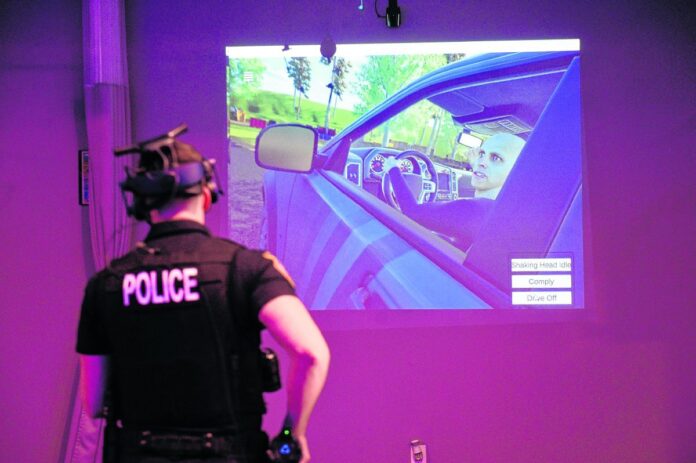
GREENFIELD — Isaac Galbraith slowly lifted the Taser from his left pocket after demanding the man standing in front of him drop the baseball bat. When the man didn’t and charged the Greenfield Police Department officer, Galbraith squeezed the trigger and dropped the attacker within seconds.
This was an exercise, not a real event. But with the help of virtual reality equipment, the training, held this week for GPD officers, came pretty close to the real thing.
When Galbraith’s exercise was over, he slightly raised the virtual reality mask off his face and listened to the critique of his performance from instructors Lt. Jimmie Condra, Detective Jerami Summers and Capt. Chuck McMichael, who told the officer he handled the situation well.
Heading into the training, Galbraith noted he had not done any similar training previously. But he knew it was going to help him be better prepared the next time he is forced to make a quick decision.
The man with the baseball bat was just one of 13 scenarios Galbraith and all officers from the GPD went through earlier this week as part of a session of de-escalation training.
“This is definitely different from the old kind of video games,” Condra said. “This is all about de-escalation when someone doesn’t necessarily respond to your commands.”
The training is designed to be a vital part of honing officers’ response and comes after the state has enacted a new law requiring de-escalation exercises. But the virtual reality aspect was unusual.
“We’re one of the first departments in this area to do this kind of training,” McMichael said. “We’ve had a lot of good feedback from our officers.”
The department conducted the two-day training at Evolution VR, 1757 Melody Lane in Greenfield, owned and operated by Terry Longworth. The business is certified through the Indiana Law Enforcement Academy as a law enforcement provider, meaning any training the officers do at the facility goes toward required training hours.
While the instructors and operator watch a video screen of the program the officers go through during the training, the officer is immersed into the scenario. He or she can move around as if they’re actually in the environment, and they get a real-life feel of how to react in tense and dangerous situations.
The program scenarios are so real an observer can watch an officer jumping out of the way of an oncoming vehicle or trying to dodge a person running at them.
McMichael noted this level of training is new to the department. The plan is to have officers go through a virtual reality program at least once a year.
Evolution VR officials reached out to the GPD in spring of 2020 to let them know software companies had created programs to help in police training scenarios. The pandemic kept the department from moving forward last year, but this year, with the business opening up and people getting out, the department jumped at the chance to do the training for a cost of about $1,000, which was a one-time price quoted for this test session of the software.
“This is a great alternative to work in additional training,” McMichael said. “It’s really cool.”
He also went through the VR training and said it was much more than he had anticipated, noting how realistic the training “weapons” are, right down to the make and model officers carry.
While many law enforcement agencies take part in role-playing scenarios during field day programs, the virtual reality takes the experience to a new level. A large number of scenarios can be programmed, from a suicidal person to a bank robbery, an active shooter or a domestic violence situation. The program can be controlled by an operator who in a second can change a scenario and how it plays out based on an officer’s decisions.
During the training, each officer taking part gets a brief description of the scenario they’re thrust into, just like they would with a normal call. Once the scenario starts, the officer responds to what he or she is seeing, including moving about.
“We’re even putting officers into positions where they have to move themselves into a cover position, walk around a neighbor, or look into a car,” McMichael said.
Brian Pryor, chief of the Shirley Police Department, had his officers take the training and said it was a worthwhile experience.
“Our guys love it,” Pryor said. “It’s about as close to being in the actual situation as can be.”
Pryor, who’s been in law enforcement for nearly 30 years, took part in the training himself and said he and his department appreciated the opportunity to have the full 360-degree experience.
“Up, down, everything around you was just like it would be in a real-life dangerous situation,” Pryor said, which he noted is normally hard to simulate in traditional training exercises. “I really love the training and highly recommend it. It really raises your heart rate, and that’s something officers need to experience working under the different stresses of the job.”




